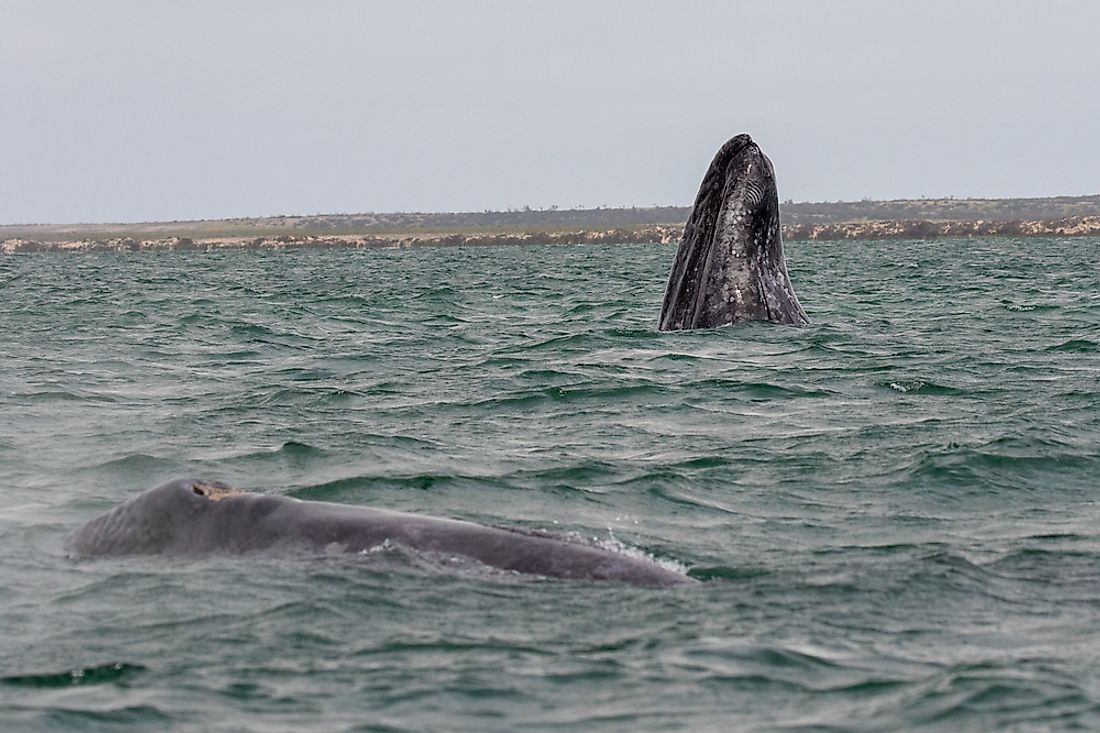Gray Whale Facts: Animals of North America

5. Physical Description
Gray whales are considered a medium-sized whale, and span up to 45 feet (14 meters). Weighing up to 33 tons (30,000 kilograms), they are often seen covered in white patches, which are actually made up of over 400 pounds (181 kilograms) of parasitic barnacles and whale lice. The females of this species are typically larger than the males, though they are both similar in appearance. Gray whales do not have dorsal fins. Instead, they have a small hump followed by six to twelve bumps behind it. They get their name from their coloration, which ranges from light gray to dark charcoal.
4. Diet
As a baleen whale, the Gray whale’s upper jaw has approximately 300 filter-feeding plates known as "baleen" hanging from it. Gray whales use their baleen as a filter to separate their food from other debris. They do this by turning so that one side of their mouths faces the ocean floor. The Gray whale then pulls in its tongue, creating a vacuum and sucking in sediment and food into its mouth. Despite their size, gray whales feed off of the smallest animals, consuming approximately 2,425 pounds (1,100 kilograms) of food each day. Their diet mainly consists of tiny, shrimp-like creatures called amphipods that live on muddy sea floors. As opportunistic feeders, they will also eat tube worms, shrimps, crab larvae, and other small fishes.
3. Habitat and Range
Gray whales are found today living in the northern reaches of the Pacific Ocean. Once, they also inhabited the North Atlantic Ocean, but were hunted to extinction there in the 17th Century. There are still over 20,000 individual Gray whales in the wild, and with a stable population size, Gray whales are listed as a species of "Least Concern" on the Internatonal Union for the Conservation of Nature's Red List of Threatened Species. The biggest threat they face remains to be human whalers. With their slow speed and coastal distribution, Gray whales make for easy targets for the whaling industry. Other threats to the whales include ocean pollution (such as that from commercial fishing gear and oil spills), noise pollution from maritime vessels, and collisions with larger boats and ships.
2. Behavior
Normally, Gray whales will travel in "pods", groups typically consisting of no more than three whales. However, during the migration season, they may travel in pods of up to 16 individuals. In the summer, they live up in the north where the ocean floors are rich with life but, in the fall and winter, Gray whales will migrate back south down to Baja California, Mexico, where their breeding grounds are. Tourists who visit their breeding grounds may occasionally come across certain whales that are “friendly”, at least in the sense that they will swim up to boats and allow people to touch them. However, Gray whales have also garnered a reputation for turning aggressive when separated from their young, so caution should always be exercised when approaching them.
1. Reproduction
Mating usually takes place in the Gray whales' seasonal breeding grounds, and the female’s gestation period can last up to 14 months, allowing her to return to the warm lagoons of Mexico once again, where she will give birth to a single calf. As a mammal, the calf will be nursed by its mother for approximately 6 months as it stays in the shallow waters with her. Because there is such a large range of time for an individual to become sexually mature, it has been suggested that size is a better indicator for sexual maturity in whales rather than age. With that in mind, it appears that Gray whales become sexually mature adults when they get to be 36 to 40 feet (11 to 12 meters) in length.







